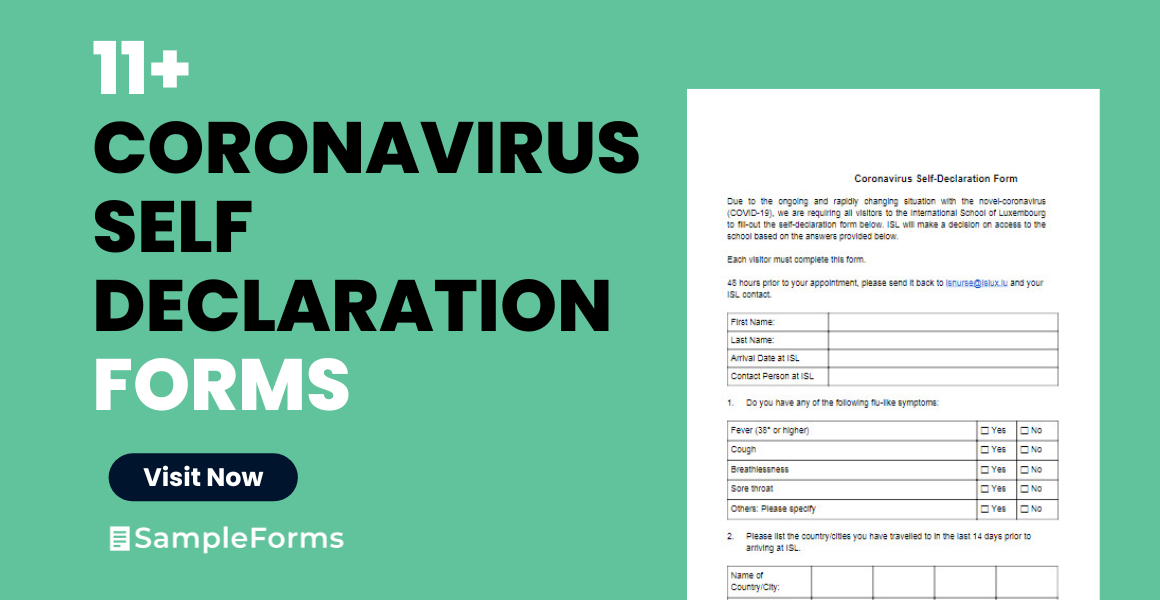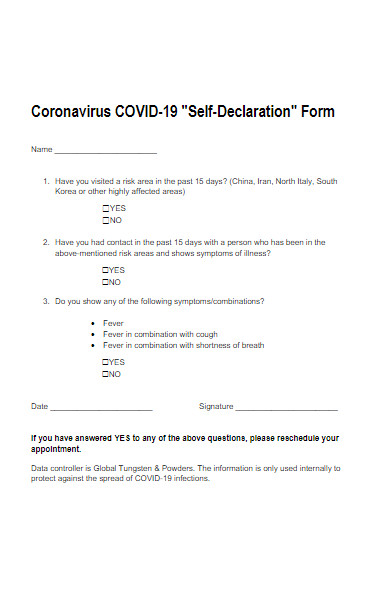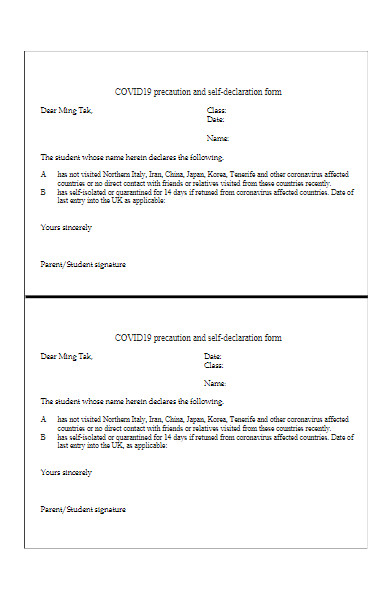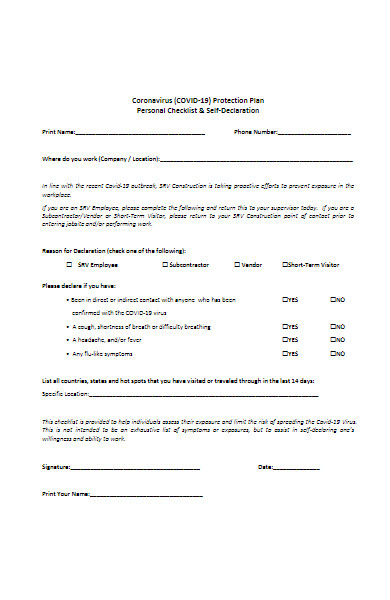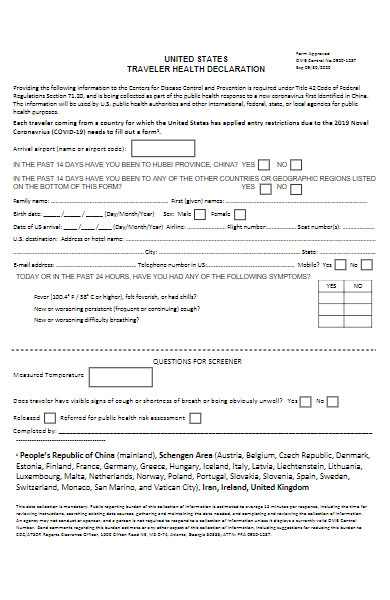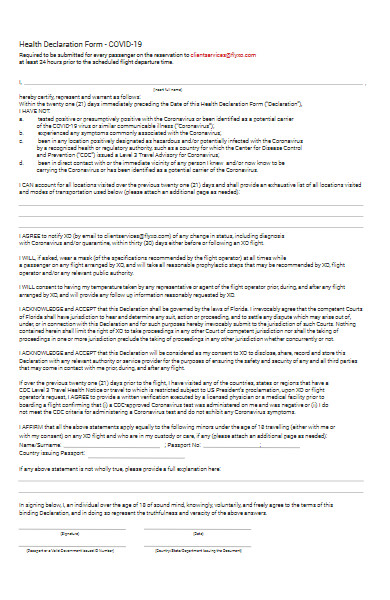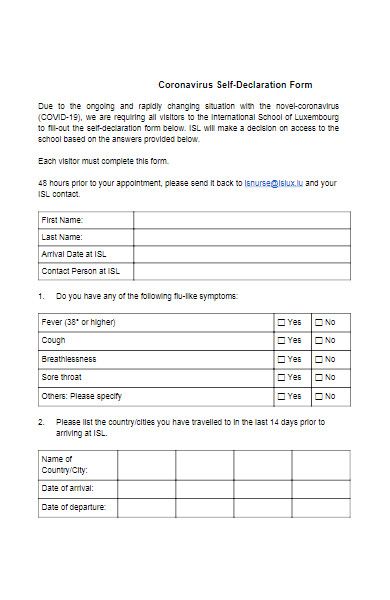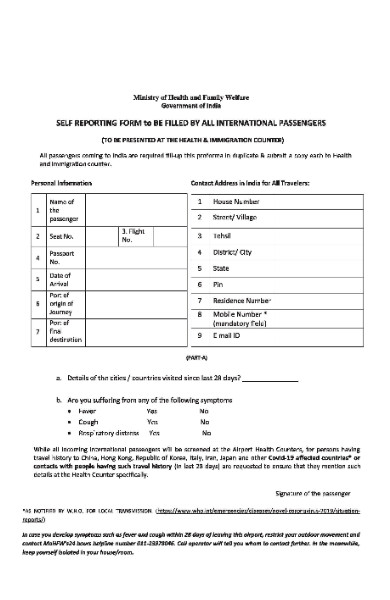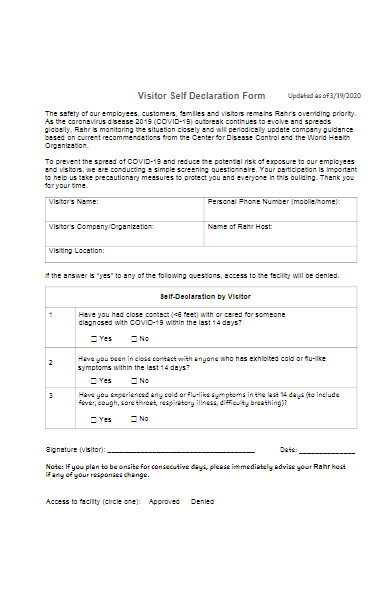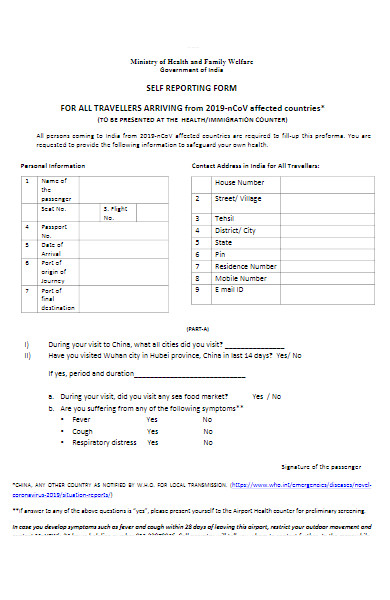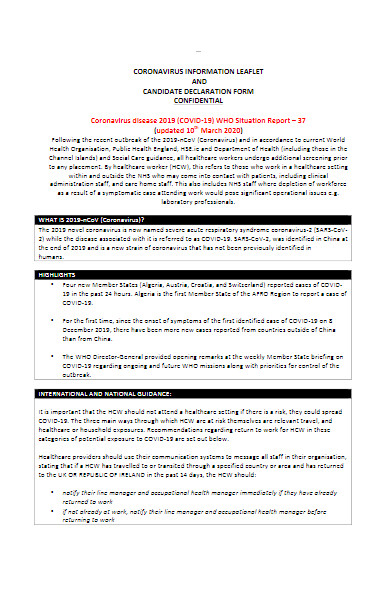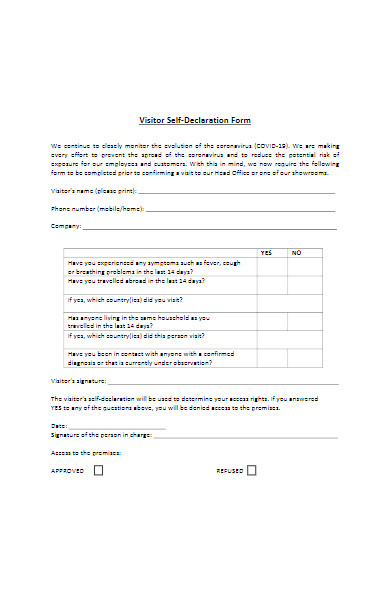In the midst of the ongoing battle against the pandemic, the Coronavirus Self Declaration Form stands as a crucial line of defense. It’s a proactive measure enabling individuals to declare their health status, travel history, and potential exposure to the virus. By employing such forms, organizations and authorities can gauge risks and take necessary precautions. This guide will delve into the various facets of these forms, their types, how to craft them effectively, and tips to ensure they fulfill their purpose of safeguarding public health.
What is a Coronavirus Self Declaration Form ? – Definition
A Coronavirus Self-Declaration Form is a document that individuals are required to complete, typically before entering a facility or boarding a flight, to declare their current health status, recent travel history, and any known exposure to COVID-19. These fillable form is a preventive health measure aimed at identifying and mitigating the risks of spreading the virus. It serves as a self-assessment tool to alert organizations and health authorities about potential carriers of the virus who may need to take additional safety precautions.
What is the Meaning of a Coronavirus Self Declaration Form?
The Coronavirus Self Declaration Form is a testament to individual responsibility and collective safety in the face of the pandemic. It signifies an individual’s attestation to their health condition, potential exposure risks, and travel history relevant to COVID-19. These printable form serves as a crucial checkpoint to inform organizations and authorities about one’s risk status, enabling them to implement necessary interventions or restrictions to prevent the spread of the virus. It’s a concrete step that individuals can take to contribute to public health efforts during these challenging times.
What is the Best Sample Coronavirus Self Declaration Form?
Here’s a sample template for a Coronavirus Self-Declaration Form that organizations can adapt and use:
Personal Information:
- Full Name: ________________________________________
- Date of Birth: ______________________________________
- Contact Number: ____________________________________
- Email Address: ______________________________________
- Home Address: ______________________________________
Health and Travel History:
- Have you experienced any of the following symptoms in the last 14 days? (Please check all that apply)
- Fever
- Cough
- Shortness of breath or difficulty breathing
- Fatigue
- Muscle or body aches
- Sore throat
- Loss of taste or smell
- Nausea or vomiting
- Diarrhea
- Have you tested positive for COVID-19 in the last 14 days?
- Yes
- No
- Have you been in close contact with someone who has tested positive for COVID-19 in the last 14 days?
- Yes
- No
- Have you traveled internationally or to a COVID-19 hotspot in the last 14 days?
- Yes
- No
If yes, please provide details: _______________________________
Declaration: By signing below, I declare that:
- The information I have provided is true and accurate to the best of my knowledge.
- I understand that providing false information could endanger the health and safety of others and may result in legal consequences.
Signature: _______________________________ Date: _______________
Instructions for Submission:
- Please return this completed form to [Insert Submission Instructions].
- If you indicated any symptoms or exposures above, please follow [Insert Protocols].
This sample form is designed to be brief yet comprehensive, capturing the essential information needed for effective health screening. It can be modified to include or exclude certain fields as relevant to the specific context in which it will be used. You also browse our Health Declaration Form.
FREE 11+ Coronavirus Self Declaration Forms
How do I fill out a Coronavirus Self Declaration Form?
To fill out a Coronavirus Self Declaration Form, follow these steps:
- Read Instructions: Carefully read any given instructions before you start filling out the form to ensure you understand what information is required.
- Personal Details: Enter your full name, date of birth, current address, contact information, and any other personal identification details requested.
- Health Information: Accurately disclose any recent symptoms you may have experienced that are associated with COVID-19, such as fever, cough, or difficulty breathing.
- Travel History: Provide details of any recent travel, particularly to areas known to have high rates of COVID-19 infections.
- Exposure Risk: Answer questions regarding any potential exposure to COVID-19, such as contact with confirmed cases or attendance at large gatherings.
- Quarantine Information: If applicable, provide information about any quarantine periods you have undergone.
- Vaccination Status: Indicate whether you have been vaccinated against COVID-19 and, if so, provide the dates and type of vaccine received.
- Signature and Date: Sign and date the form to verify that the information you’ve provided is true and accurate to the best of your knowledge.
- Submit the Form: Follow the submission guidelines provided by the authority or establishment requesting the form. This could mean handing in a physical copy or submitting it online.
Always remember to provide truthful and up-to-date information. Falsifying a self-declaration form can have serious consequences, including legal action. You should also take a look at our Health Declaration Form.
Where can I find a Coronavirus Self Declaration Form online?
You can usually find a Coronavirus Self Declaration Form online through several official sources:
- Government Health Departments: National or local health department websites are a primary source for such forms, especially for international travel or entry to government buildings.
- Airline and Travel Company Websites: If you’re traveling, airlines or travel companies often provide these forms as part of the check-in process.
- Workplaces and Educational Institutions: University and company websites may have these forms available for students, employees, or visitors.
- Event Organizers: For events, check the event organizer’s website or your registration confirmation materials for a link to the form.
- Healthcare Providers: Hospital and clinic websites may require patients to fill out a self-declaration form before appointments, which can typically be found on their patient information or COVID-19 resource pages.
Always look for the blank form on official and reputable websites to ensure that you’re using the correct and most up-to-date version.
Is the Coronavirus Self Declaration Form mandatory for travel?
Whether a Coronavirus Self Declaration Form is mandatory for travel depends on the current travel regulations set by the countries of departure and arrival, airlines, and other transportation authorities. These requirements can change frequently in response to the evolving pandemic situation. It is crucial to check the latest travel advisories from official sources such as government health departments, embassies, or airline websites before traveling. Our Medical Declaration Forms is also worth a look at
What information is required on a Coronavirus Self Declaration Form?
A Coronavirus Self Declaration Form typically requires the following information:
- Personal Identification: Full name, date of birth, contact information, and sometimes national identification or passport number.
- Health Status: Recent symptoms related to COVID-19, such as fever, cough, shortness of breath, and loss of taste or smell.
- Travel History: Details of recent travel, especially to areas with high infection rates.
- Exposure: Any known exposure to COVID-19 cases.
- Quarantine Details: Information about any self-quarantine measures undertaken.
- Vaccination Status: Whether you have been vaccinated against COVID-19, including dates and types of vaccine, if applicable.
- Consent and Acknowledgment: Affirmation that the information provided is true, and sometimes consent for a health check or agreement to follow quarantine rules if necessary.
- Signature: To validate the form.
This form may be required by authorities to assess an individual’s health risk in relation to COVID-19.
How often do I need to update my Coronavirus Self Declaration Form?
The frequency with which you need to update your Coronavirus Self Declaration Form can depend on the specific requirements of the authority requesting it, the purpose of the form, and any changes in your health status or exposure risk. Typically, you may need to update and submit a new form:
- Before Each New Event: If the form is for entry to a specific event or location, you’ll likely need to fill it out each time you attend.
- For Ongoing Employment or Education: Some workplaces or educational institutions may require regular updates, such as daily or weekly, depending on their COVID-19 policies.
- When Your Circumstances Change: If you develop symptoms, test positive for COVID-19, or have been exposed to someone who has, you should update your form immediately.
- Travel: Each time you travel, especially internationally, you may be required to fill out a new self-declaration form reflecting your most recent health and travel information.
Always check the current guidelines provided by the relevant health authorities, employers, or other organizations to know exactly when to update your form. In addition, you should review our Patient Declaration Form.
Who needs to complete a Coronavirus Self Declaration Form?
A Coronavirus Self Declaration Form typically needs to be completed by:
- Travelers: Individuals traveling, especially internationally, as required by airlines, immigration, or health authorities.
- Employees: Workers returning to the workplace or attending a physical location for their job.
- Students: Those attending in-person classes at educational institutions.
- Event Attendees: Guests at events, conferences, or gatherings where close contact is expected.
- Visitors: Individuals visiting healthcare facilities, nursing homes, corporate offices, or any other place where entry screening is mandated.
- Patients: People seeking in-person medical consultations or procedures.
The requirement can vary based on local regulations and organizational policies in response to the pandemic.
How is the data from a Coronavirus Self Declaration Form used?
The data from a Coronavirus Self Declaration Form is typically used for:
- Health Screening: To assess the risk of an individual carrying or being exposed to the virus, potentially mitigating the spread within a community or specific setting.
- Contact Tracing: If an individual tests positive, the information can help authorities quickly trace and inform others who may have been exposed.
- Resource Allocation: Health organizations may use the data to allocate medical resources or direct individuals to testing and vaccination centers.
- Policy Implementation: Organizations use the data to enforce their health and safety policies, such as requiring self-isolation for those with symptoms.
- Epidemiological Tracking: Public health authorities may use aggregated data for tracking and managing the pandemic’s spread.
The collected data should be handled with strict adherence to privacy laws and regulations.
How to Create a Coronavirus Self Declaration Form?
Creating a Coronavirus Self-Declaration Form involves several steps. Here’s a step-by-step guide:
Step 1: Determine the Requirements
- Identify what information is required, such as personal details, recent travel history, symptoms experienced, and contact with confirmed cases.
- Check for any legal requirements or data protection regulations that apply to collecting health information.
Step 2: Choose a Platform
- Decide whether the form will be digital or paper-based. Digital forms can be created using platforms like Google Forms, Microsoft Forms, SurveyMonkey, or a custom solution.
Step 3: Design the Form
- Start with basic personal information (name, contact details, date of birth).
- Include a section for recent travel history, focusing on dates and locations visited.
- Add questions about symptoms related to COVID-19, such as fever, cough, difficulty breathing, loss of taste or smell, etc.
- Inquire about contact with any confirmed or suspected COVID-19 cases.
- Ensure there is a declaration statement where individuals affirm that the information provided is true to the best of their knowledge.
Step 4: Include Instructions and Consent
- Provide clear instructions on how to fill out the form.
- Include a consent clause for data handling and sharing, compliant with privacy laws.
Step 5: Review and Test the Form
- Have the form reviewed by a legal advisor to ensure compliance.
- Pilot the form with a small group to identify any issues or unclear questions.
Step 6: Implement Distribution and Collection Mechanisms
- If digital, share the form link via email, QR code, or on a website.
- If paper-based, ensure there are protocols for distribution and collection that maintain social distancing.
Step 7: Data Management Plan
- Set up a secure method for storing the collected data.
- Establish protocols for who can access the data and how it will be used.
Step 8: Monitor and Update
- Regularly review the form and update it as guidelines and information about COVID-19 evolve.
Step 9: Ensure Accessibility
- Make sure the form is accessible to everyone, considering language and disability.
Step 10: Legal and Ethical Considerations
- Be transparent about why you are collecting the data and how it will be used.
- Ensure the form complies with local and international data protection and privacy regulations.
Step 11: Communication Plan
- Develop a plan to communicate with those who have filled out the form if needed, for contact tracing or updates.
Step 12: Implementing Feedback
- Allow for a mechanism where individuals can provide feedback on the form for continuous improvement.
Step 13: Training
- If applicable, train staff on the proper use and handling of the forms and data collected.
When you have completed these steps, your form should be ready for use. Keep in mind that the situation with COVID-19 is continually evolving, so the form may need to be updated periodically to reflect new guidance or regulations. You may also be interested in our legal declaration forms.
Tips for creating an Effective Coronavirus Self Declaration Form
Creating an effective Coronavirus Self Declaration Form is crucial for collecting accurate health information and preventing the spread of COVID-19. Here are some tips to ensure your form is both effective and efficient:
- Keep it Simple and Clear: Use straightforward language and avoid medical jargon. Ensure that all questions are easy to understand.
- Make it Concise: Only ask for essential information to minimize the time required to complete the form and reduce drop-off rates.
- Ensure Accessibility: The form should be accessible to people with disabilities and available in multiple languages if it serves a diverse population.
- Privacy Matters: Clearly state how the information will be used and ensure the form complies with privacy laws such as GDPR or HIPAA.
- Use Conditional Logic: If using a digital form, implement conditional logic that guides respondents through the form based on their previous answers, which helps in gathering more tailored information.
- Mobile-Friendly Design: Since many users will access the form on their mobile devices, ensure the form is responsive and mobile-friendly.
- Provide Clear Instructions: Include instructions for each section and question, specifying what type of information is needed.
- Incorporate a Verification Step: Add a step for individuals to review their answers before submission to reduce errors.
- Regular Updates: Keep the form updated with the latest public health guidelines and information.
- Secure Data Handling: Use secure platforms for digital forms and ensure any paper forms are stored and disposed of securely.
- Confirmation Receipt: Send an automatic confirmation receipt to the respondent with information on the next steps or any relevant health guidance.
- Feedback Loop: Provide a way for users to give feedback on the form itself, which can help you to continually improve the process.
- Contact Information: Include contact information for individuals who have questions or need support in completing the form.
- Visual Engagement: Use visual cues such as icons or color coding for different sections to make the form more engaging and easier to navigate.
- Mandatory Fields: Clearly indicate which fields are mandatory to prevent incomplete form submissions.
- Legal Compliance: Regularly consult with legal advisors to ensure the form meets all regulatory requirements.
- Integration with Health Systems: If possible, integrate the form with health systems for efficient data management and contact tracing.
- Training for Staff: If your form is part of an organization’s screening process, ensure staff are trained on its use and the importance of confidentiality.
By following these tips, you can create a Coronavirus Self Declaration Form that is thorough, user-friendly, and compliant with health and safety regulations.
A Coronavirus Self-Declaration Form is a document used to assess an individual’s health status and COVID-19 risk factors. It typically includes personal details, travel history, symptom checks, and exposure to the virus. Types vary from digital to paper formats. An effective form is clear, concise, accessible, and legally compliant. To create one, gather necessary details, choose a platform, design, test, and ensure secure data management. You may also be interested to browse through our other Employee Declaration Forms and Participant Declaration Form.
Related Posts Here
-
Restaurant Schedule Form
-
Mobile Home Bill of Sale
-
Landlord Consent Form
-
60-Day Notice to Vacate Form
-
Financial Statement Form
-
Product Evaluation Form
-
Construction Contract
-
School Receipt Form
-
Restaurant Training Form
-
Daily Cash Log
-
Volleyball Evaluation Form
-
Holding Deposit Agreement Form
-
License Agreement Short Form
-
Fund Transfer Form
-
Business Financial Statement Form
